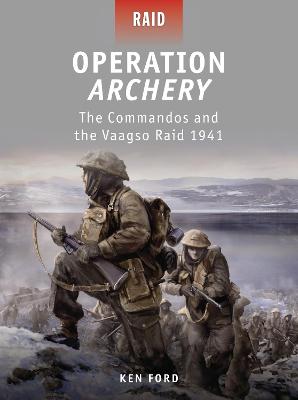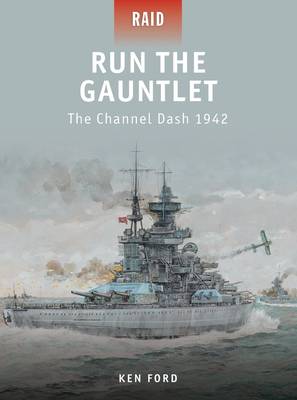Raid
4 primary works • 5 total works
Book 8
On the night of December 7, 1942, five canoes were launched off the mouth of the Gironde river, each containing a pair of British commandoes tasked with slipping into the port of Bordeaux and destroying as many of the merchant ships as possible. Only two of the canoes made it to the target, but it was enough. Five enemy ships were badly damaged in the attack. It then became a game of cat and mouse for the surviving commandoes in their attempt to get back to Britain. Some of the men made it to Gibraltar; others were caught and executed. Author Ken Ford gives a blow-by-blow account of one of the most daring raids of World War II, which badly upset the flow of material into Germany, and which gave the British public a much needed victory.
Book 13
In the darkest days of World War II, the British planned a daring airborne operation to capture the secret of the new German radar. Lead by Major John Frost, a company of paratroopers dropped into Bruneval on the French coast, and quickly neutralized a small German garrison. Then began a desperate fight for time as the British tried to dismantle the German radar and evacuate back to England, as ever more German units converged on their position. Using artwork, photographs, and detailed maps, this action-packed narrative puts the reader in the planning room and on the battlefield of one of the greatest raids of World War II.
Book 21
Operation Archery, the raid on Vaagso and Maaloy in Norway on 27 December 1941, was the first true combined operation carried out by British forces involving the Army, Royal Navy and the Royal Air Force. The Islands of Vaagso and Maaloy on the Norwegian coast between Bergen and Trondheim, were selected because they offered a perfect opportunity to damage German installations and morale. Mountbatten, the new head of Combined Operations, hoped to eliminate the local garrison, destroy the fish oil factories and sink enemy shipping. The raiding force consisted of No. 3 Commando, two troops of No. 2 Commando, a medical detachment from No. 4 Commando and a Royal Norwegian Army detachment totalling 51 officers and 525 men. To support the amphibious raid was a flotilla of warships and low-level bomb attacks by the RAF. The raid was launched on Christmas Day 1941, taking the German defenders entirely by surprise. German resistance was stiff, however, and a fierce firefight ensued. Relive the nail-biting action of one of the great raids of World War II in this exciting book, packed with maps and photographs.
Book 28
In February 1942, three of the major ships of the German surface fleet - the battle-cruisers Scharnhorst and Gneisenau, and the heavy cruiser Prinz Eugen - stormed out of the harbour at Brest on a dramatic voyage back to Germany. Passing through the straights of Dover, the ships faced everything the Royal Air Force and the Royal Navy could throw at them. In a dramatic running fight, the ships managed to sail right under the nose of history's greatest maritime nation to reach the safety of Germany. The brilliantly executed operation brought great humiliation to the British - Hitler, who had developed the plan, had judged perfectly the reaction of the British command to the Channel Dash. This book tells the complete story of this great race, from the planning through to the repercussions of this unique Germany victory.
On the night of December 7, 1942, five canoes were launched off the mouth of the Gironde river, each containing a pair of British commandoes tasked with slipping into the port of Bordeaux and destroying as many of the merchant ships as possible. Only two of the canoes made it to the target, but it was enough. Five enemy ships were badly damaged in the attack. It then became a game of cat and mouse for the surviving commandoes in their attempt to get back to Britain. Some of the men made it to Gibraltar; others were caught and executed. Author Ken Ford gives a blow-by-blow account of one of the.




